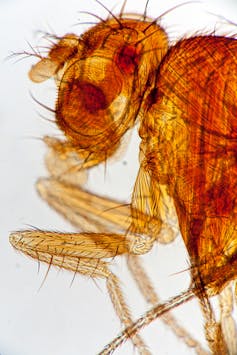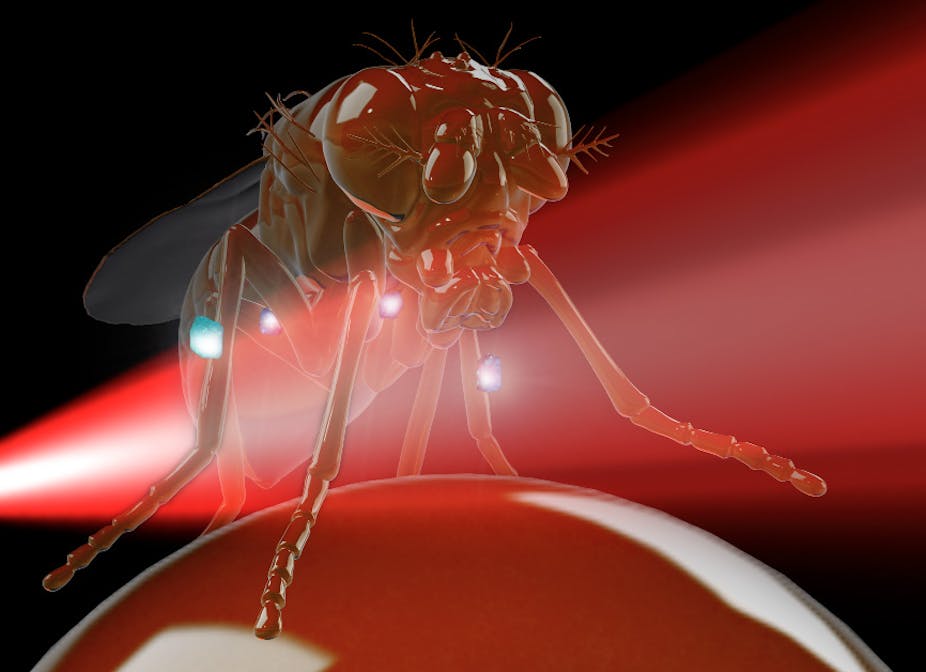After many years of research, we still do not completely understand the brains of even the simplest organisms. The human brain with its 80 billion neurons is largely a mystery. But with better tools we are learning to unravel this complexity.
Current methods used to study human brains can only highlight large areas of the brain responding to activity. With each neuron connected to hundreds of others, the sheer complexity makes it difficult to pinpoint the role of single neurons. Only simple organisms such as a simple round worm (Caenorhabditis elegans), which has only 302 neurons, can be understood at the level of each individual neuron. The next animal on the ladder of increasing complexity that will be understood at this level is the fruit fly (Drosophila melanogaster), which has about 100,000 neurons.
My lab at Harvard University investigates why some animals behave one way, while closely related animals behave another. To understand this, we study the humble fruit fly. The hope is that studying how flies move and scrutinising their behaviour will inform our understanding of the fly’s brain at the level of single neurons.
Within neuroscience, one field that has advanced faster than others is behavioural neuroscience, in which the behaviour of an organism is correlated with its brain activity. Previously, researchers would have to be present in dark rooms watching flies and clicking tally counters when a fly made a certain move. Instead today, cheaper cameras and faster computing power allow scientists to automate many of these activities. A modern lab features imaging rigs feeding data into computers for real-time processing.
In our earlier investigations of the behaviour of flies, such as their response to light, we have tried to answer a series of questions: What path does a fly follow as it moves toward light? What elementary runs and turns make up that path? What are the fly’s individual legs doing as it executes those runs and turns? Now, in a paper published this week in the journal Nature Communications, we report a new method to study this behaviour at the finest scale possible.
Motion capture on the fly

Flies are tiny - 2.5mm long - and their legs tinier. To record their position and motion, we borrowed a technology applied to humans: motion capture, which is commonly used in computer-generated imagery for movies. Instead of dressing flies in black suits adorned with ping pong balls, we glue a very small piece of dye to each of their legs.
The fluorescent dye shines only under infrared light, which is completely invisible to the fly. This means we can track its behaviour without it even noticing. This requires dextrous coordination of tiny pins and forceps under the microscope.
Once the fly is marked with the dye, we glue its back to a wire and mount it on top of a clear plastic ball. The ball itself is floating on a cushion of air, flowing from below, which allows it to turn with very little friction – so little that the fly can easily turn the ball with its tiny legs. In effect, the fly is now walking on a boundless two-dimensional treadmill, and we can record its motion using laser sensors extracted from technology found in your computer mouse.
We are not the first to experiment by putting an insect on a ball. Scientists have been doing it since the 1950s. Our insight was that a clear ball would allow us to image leg positions, as indicated by the spots of infrared dye, by looking up through the ball, which now acts as both a lens and a treadmill simultaneously.
A fly on the ball
With leg-tracking methods in place, we were able to conduct a number of experiments. First, we examined whether a computer could automatically classify what the fly was doing from moment to moment - running, turning, or grooming (which, like cats, flies do a lot). Our results using simple machine learning algorithms showed that computers could evaluate what the fly was doing essentially as well as human observers.
Second, we asked what differed in the leg-motion patterns between individual flies. Surprisingly, we found that individual flies have persistent, idiosyncratic patterns in how they move from one behaviour to another. For instance, one fly routinely started grooming its abdomen after resting motionless, while another fly never performed these behaviours in sequence. It is these sorts of differences, now that they have been observed, which our research is focused on understanding.
Finally, we found that despite these behavioural differences, when flies were presented with coherent visual feedback – such as when they turned to the left, the environment correspondingly moved to the right – their behaviour became more similar. This suggests that their brains are not simply sending rote commands to their legs. Instead, the visual information was continuously being used to make the motor patterns robust to the peculiar traits of each animal’s nervous system.
One night we accidentally left a fly mounted to the rig. The next day, there it was, happily running on the ball after 16 hours of no food or water. They are creatures of surprising resilience. We hope this resilience means we can push the limits of our imaging system by simultaneously recording their leg motion, ball motion and neural activity in the the brain. This would involve opening the fly’s “skull” and imaging its brain with a specially-built microscope. Hopefully then we will be able to identify which single neurons become active as flies implement each of the detailed behaviours the leg-tracker can record.

